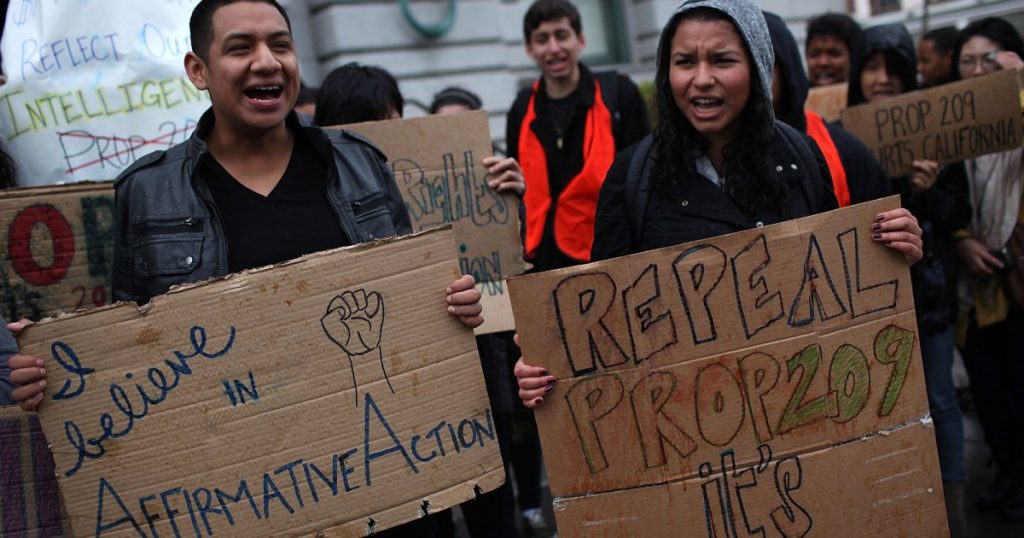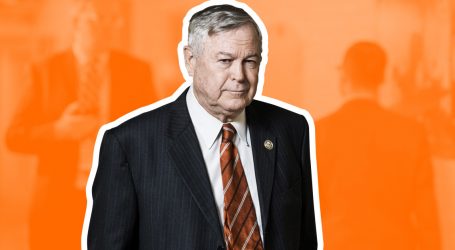Californians Love to Brag About Their Wokeness. So Why Do They Keep Rejecting Progressive Ballot Measures?
Students hoping for a repeal of California’s Proposition 209 hold signs as they protest outside of the Ninth U.S. Circuit Court of Appeals on February 13, 2012. Justin Sullivan/Staff/GettyImages
Let our journalists help you make sense of the noise: Subscribe to the Mother Jones Daily newsletter and get a recap of news that matters.Daniel Ho-Sang learned the hard way not to put much faith into California’s ballot measures. Back in the 90s, when Ho-Sang was working as an activist focused on police accountability and environmental justice, a wave of conservatism found its way into statewide ballot initiatives. Ho-Sang watched in horror as 59 percent of voters approved a Republican-driven ballot measure that barred undocumented immigrants from government health care services and public education, and again when an initiative banning affirmative action in colleges, universities, and public agencies was approved.
“The narrative that many of us believed was that California voters were tricked by outside interests and that the measures contradicted what the larger populace wanted,” Ho-Sang says. Indeed, Prop 187, the anti-immigrant initiative, put on the ballot during a recession and propped up by then-Republican Gov. Pete Wilson, galvanized Latino voters and helped turn California into the solidly blue state it is today.
But since Prop 187, Californians have rejected one progressive initiative after another, meanwhile approving conservative measures that seemingly contradict the states liberal bona fides. This year, voters passed a tech company-backed measure classifying gig workers as independent contractors and, amid a statewide housing affordability crisis, rejected a measure that would have allowed cities and counties to expand renter protections. Ho-Sang, now an associate professor of Ethnicity, Race & Migration and American Studies at Yale University, no longer sees the moment two decades ago as singular. In his 2010 book Racial Propositions: Ballot Initiatives and the Making of Postwar California,Ho-Sang concludes that California’s reputation as a bastion of liberalism is a shield that allows voters to support ballot initiatives that deepen the state’s profound inequities.
“What’s remarkable in the last four years is that, on the one hand, California’s been a bulwark against Trumpism,” Ho-Sang says. But the same voters who went for Biden by nearly two-thirds in November failed to pass Prop 16, a measure repealing the ban on affirmative action passed in the 90s. Voters also rejected a tax hike on commercial properties that would have generated billions in revenue and enshrined independent contractor status for gig workers. The only progressive win on initiatives this fall was the restoration of voting rights for formerly incarcerated people on parole. “The current commitment to liberal values alone is not going to be the basis to” enact laws that advance equity.
I spoke to the Yale professor about the disconnect between what Californians say they believe in and how those values are put into practice, and what organizers can learn from this moment.
Why did California voters reject this effort to repeal the ban on affirmative action last month?
There are parts of the story that are deeply surprising in the bigger picture, and then when we zero in a little closer, perhaps less surprising. In the 1990s, the theory was always that the largely white electorate was key to the passage of these measures. When the demographics and composition of that electorate changed, so too would California politics. Part of that story has been borne out if you look at the domination of Democrats across all levels of statewide government.
But if you had told any of us in the mid-90s that, 25 years later, a much more diverse electorate, and a public discourse more aware of discrimination and structural racism, would be voting to undo the ban on affirmative action, we would have predicted that a measure like this would pass in a landslide. That’s the surprising part. There’s a way in which this didn’t follow the pretty deeply held set of assumptions about the relationship between the electorate and their preferences.
If we zoom in a little closer, we can see a number of things. Certainly, competing with COVID, a presidential election, lots of other well-funded, high profile measures on the ballot, I don’t think helped. There’s also a way that affirmative action itself, which used to be closely identified with achieving racial equity and the fight against discrimination, has also faded from public consciousness and salience. The very belief that universities can credibly ensure equal opportunity for all Californians is itself no longer a widely embraced proposition. In the mid-90s, you could assume that a prospective voter would hear the term affirmative action and associate it with civil rights and anti-discrimination work. I just don’t think that it is as tightly bound today. People don’t think of affirmative action as much and they don’t necessarily think of it in that way. The very notion that universities and the government can ensure fairness has also started to wither.
It makes me think about the way people opposed to Prop 16 framed the issue. They said, essentially: if you allow affirmative action, you’re making discrimination legal. It’s a push from the opposition for this colorblindness in an unequal American society.
The interesting thing is, I think that was absolutely also the framing of the 90s version. It was called the civil rights initiative. Remember, this was an initiative that was almost dead in the water a year before it came on the ballot. But that colorblind language is what resonated. So I think all those dynamics operated really powerfully in the 90s.
In the polling before Election Day, the chief opposition to repealing the affirmative action ban came not just from white voters and a small but vocal minority of Asian American voters, but also Latino voters. What do you think explains that?
My guess is that now, the electorate actually is much more savvy about the persistence of discrimination. With the college admission scandal and the incredible difficulty of paying for college, nobody believes anymore that these institutions are neutral. Everyone across the political spectrum feels like the institutions are balanced against them. But the notion that affirmative action is a remedy to that, it seems almost naïve. Structurally, there are so many flaws in these processes that this measure might have done a little to address them.
So my guess is this just seemed like another finger on the scale—this just didn’t seem like a way to address it. In the end, people might have felt like, well, someone’s got to lose out, and what if it’s me? In other words, I think many of those voters would generally agree with the statement that “discrimination continues to be pervasive and opportunity is far from equal,” but they just don’t associate affirmative action as a solution to it.
What explains this disconnect between how Californians vote for propositions and how they vote in big presidential races?
This is an unbroken pattern in post-World War II California politics. Just as one example, in 1964, California in a landslide goes for Lyndon Johnson over Barry Goldwater. All polls suggest voters are deeply supportive of civil rights, but they vote by a two to one margin to make racial discrimination in housing a constitutionally protected practice. There’s just a long history of that.
It’s like this disconnect where California voters can communicate broadly their support for certain values and principles, but they have a more difficult time applying it to making concrete changes in their own backyard. For me, the rent control measure really stands out. Part of the argument I make in the book is that: If you’re trying to understand how it is that this progressive state is also the first state to ban affirmative action, the first state to ban bilingual education, one of the first states to overturn housing and school desegregation efforts, it’s because the voters think of themselves as liberal, and therefore, when they’re taking those actions, they’re not malicious. They’re innocent, in some ways. That’s arguably why the fight against affirmative action takes root in California versus say, Alabama, where it actually would be tinged because of that state’s history with a certain kind of animus. Most of the voters that both approved the affirmative action ban in 1996 and voted against its repeal this year in no way imagine themselves as acting with animus or discrimination. That’s the central paradox of California politics.
What does that tell us about how progressive California is? It’s framed as this progressive bastion, but then you look behind the curtain and it’s a bit more complicated than that.
It’s far more complicated. It tells us about the limits of simply declaring the electorate progressive. Liberal and progressive values can also be used to preserve deeply unequal structures. Look at income inequality. The housing crisis, the profound gaps in wealth—those all coexist side by side with a very progressive electorate. Those contradictions are nothing new.
Many skeptics say there’s no way California voters are going to make housing discrimination constitutionally protected. California voters in the 1960s were very supportive of civil rights, on the one hand, and on the other hand, believed that homeowners had the right to decide who they wanted to rent to, even if that belief meant that many thousands of Californians would be shut out of decent housing. Or in the 70s to believe that school desegregation diversity was a good thing but the district had no business using busing or even very minor measures to integrate local schools. What these measures show is that voters can accommodate these contradictions. They can imagine themselves to be open-minded and forward-thinking, and because of that, they find justifications to preserve these deep forms of inequality.
Here’s another way to put it: People profess liberalism and progressive values and tolerance, but those are not enough to guide voters in opposing measures that clearly reinforce inequality. It’s not that they’re duplicitous. It’s that those principles and commitments are inadequate.
It shows that if California is going to really address some of these profound crises in education and housing in particular, it’s going to require a deeper sense of public solidarity. That’s what’s in much shorter supply: some sense that Californians need to step up for one another.
That seems like a very difficult thing to garner in a massive state. I’m just thinking about the affirmative action initiative. When you look at the breakdown of who overwhelmingly supported it, it was the Bay Area and Los Angeles, and the rest of the state just opposed it. How do you build that deeper sense of solidarity around these issues?
It’s much more likely to be built regionally within municipalities, where there’s just a little more sense of interdependence—we’ll rise and fall together. You drive through Los Angeles or parts of the Bay Area, and you can’t imagine someone else is coming for your status or stature.
It’s a huge order. What we call liberal politics isn’t enough to presume those kinds of solidarities.
The restoration of voting rights is one example. That’s the effect, it seems to me, of a decade or more of both grassroots work, people from across the political spectrum acknowledging that the prison buildup was a failure, that crises and addiction have taken deeper roots, and that it wasn’t working. I don’t think the same conversations around, let’s say, higher education or taxes or housing have taken place.
What lessons can organizers around these initiatives learn from?
For the organizers, there’s long been a lesson that it’s hard to move the needle of public opinion and consciousness during elections. It’s not surprising that it proved so difficult to do any kind of meaningful voter education this year.
One of the most important legacies [from the 90s] was, when I was there, many of the community organizing groups and labor groups had no experience organizing around ballot measures, or even doing much electoral organizing at all. People did not use voter lists, they didn’t think about how you integrate with electoral work. That’s changed profoundly. Some of the most sophisticated organizing is coming out of California. People are really competent at that. It was a recognition among some very astute organizers in the 90s that to play a role in shaping the future of the state, people had to have more capacities around electoral politics. It was difficult to do that around Prop 16 because of the pandemic and other competing things. But that’s not something to be underestimated—the kind of coalition of labor and community organizations and donors are formidable. It actually speaks to the notion that it’s not fully demographics that determine elections. It’s also the formations they’re in, the groups they’re connected to, their own experiences with politics. That this election doesn’t change anything about.
This conversation has been lightly edited for clarity.




